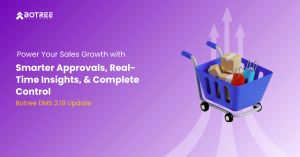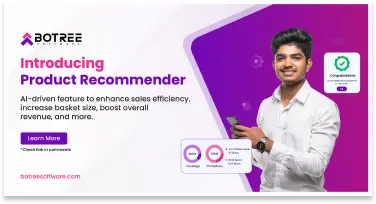
Power Your Sales Growth with Smarter Approvals, Real-Time Insights, & Complete Control with DMS 2.19 Update
Power Your Sales Growth with Smarter Approvals, Real-Time Insights, &

Power Your Sales Growth with Smarter Approvals, Real-Time Insights, &

Introducing the AI-Driven Product Recommender to Maximize Basket Size at Every Outlet
We are thrilled to introduce our latest innovation, the Product Recommender, designed to transform the way businesses optimize their product offerings and enhance sales productivity.

Sales beat planning is more than just plotting routes on a map – it’s the engine behind your field sales performance in this fast-moving FMCG world. A properly organized beat plan guarantees that your sales team connect with the right retailers at optimal times, fostering better relationships, improved stock availability, and ultimately, increased sales. When executed correctly, it transforms each outlet visit into a chance for profit. You achieve better coverage, quicker order processes, and sales team who concentrate where they’ll have the greatest effect.
However, what happens when executed incorrectly?
Frequent stockouts, missed sales opportunities, and hours lost on low-priority visits. Inefficiently planned routes result in missed visits, stockouts at key outlets, and wasted hours on low priority stops. Retailers sense a lack of attention. Order decline. Sales teams experience exhaustion. And most concerning, you fall behind competitors who appear more consistently and more frequently.
Our blog on Understanding Beat Plan and Permanent Journey Plan gives you the complete picture of how beat planning should work — a perfect follow-up once you’ve uncovered what’s going wrong.
In this blog, we’ll explore four proven ways to strengthen your sales beat planning and boost retail reach—rooted in practical insights, real sales data, and smarter territory management. These strategies don’t just fix inefficiencies; they create a more responsive, high-impact sales engine that adapts to what’s really happening on the ground.
Let’s break them down one by one.
The first mistake FMCG companies commit in sales beat Planning is employing a territory-based method that categorizes all outlets uniformly. This “equal treatment” might seem like a normal practice but in truth, it weakens sales effectiveness.
The issue is that many field sales teams are frequently visiting less important outlets, while valuable, high-volume outlets are being overlooked. This disparity produces a chain reaction. Sales team spend most of their time on outlet with low conversion rates, leaving strategic accounts overlooked. Ultimately, it leads to ineffective time management, reduced retail sales, and a continuous drop in sales conversion rates.
This is where intelligent Market Segmentation transforms the landscape. By classifying outlets according to real sales data — including order volume, payment records, and product turnover — you start to understand where your sales team as to focus on their efforts. The highest 20% of outlet frequently produce 80% of sales. However, in the absence of segmentation, they are frequently neglected.
So, how do you shift from generic territory coverage to personalized, high-impact routing?
Today’s top sales teams leverage data and automation to operate more intelligently, not with increased effort. The key? Knowing which outlets deserve more time and attention — while allowing AI to manage the decision-making process effortlessly and expansively
Standard beat plan waste time and opportunities. Strategic segmentation guarantees that your sales team targets outlet that truly make an impact, enabling you to operate more efficiently rather than with more effort.
Dabur India was facing productivity issues due to outdated, territory-based beat plan.
High-value outlets were frequently overlooked, while low-priority outlets received too much attention, hindering retail interaction and sales progress.
Dabur implemented AI-driven outlet segmentation and dynamic PJP scheduling by adopting Botree SFA. This change enabled their field sales team to concentrate on top-performing outlets without increasing the team size.
The outcome? Enhanced coverage, stronger retailer connections, and increased sales effectiveness — all driven by smart beat plan.
Seasonal and regional purchasing trends are essential for retail sales, nonetheless, many FMCG company continue to use fixed beat plan that overlook this vital factor. What is effective in the summer heat doesn’t always hold in winter. What sells in Kerala may not move in Maharashtra. However, when sales beat Planning fails to adjust, brands experience excess inventory in one area and shortages in another.
Conventional Permanent Journey Plan (PJP) frameworks often stick to a fixed schedule that does not account for the fluctuations in regional and seasonal demand. For example, picture a beverage company still promoting summer products in cold-weather regions in December. The result? Excess stock, minimal order quantities, and dissatisfied retailers holding unsalable merchandise. In the meantime, rapidly selling items in a different area become unavailable because of miscalculations.
The problem isn’t the product placement; its inadequate sales forecasting resulting from insufficient localized data. Without immediate insights or adaptability in beat plan, field sales team cannot adjust according to market demands. You miss chances to upsell during festivals, tailor promotions to fit local tastes, or even react to climate-induced shifts in consumer behaviour.
Top-performing FMCG brands don’t treat demand as static — they localize their sales beat plan to stay aligned with what’s selling, where, and when. By integrating real-time regional insights and seasonal triggers, they equip their sales team to be in the right place, at the right moment, with the right product mix.
Consumer demand is not fixed — your marketing strategy shouldn’t be either. By aligning your sales routes with current regional and seasonal trends, you remain pertinent, adaptable, and prepared for revenue.
Add seasonality tags to each outlet (e.g., “monsoon,” “festival,” “summer”). Use these tags to adjust PJPs before peak periods—ensuring sales team prioritize high-demand outlets during critical sales windows.
What succeeded last quarter might not be effective now — nevertheless, many FMCG brands continue to depend on inflexible PJP frameworks that remain unchanged. The outcome? Sales team maintain their visits to the same outlets with the same regularity, irrespective of the actual performance of those outlets. This fixed planning consumes time, limits opportunities, and slowdowns momentum in growing markets.
Imagine a shop that used to be your best performer has experienced a 40% decrease in order frequency. In the meantime, a nearby new outlet is making larger, more frequent orders, yet hasn’t been included in the current rotation. If your PJP fails to update in real-time according to sales projections and outlet results, you’re not just overlooking indicators — you’re hindering growth.
This error severs the link between field sales and data. Your team might be working hard, but the visits don’t match the current sales patterns. It results in insufficient involvement of rapidly growing outlets and excessive servicing of retailers who no longer align with your objectives. As time passes, sales team become less confident in the system — and retailers start to doubt your brand’s responsiveness.
In this retail environment, your beat plan needs to adjust as the market changes. Utilizing real-time information enables brands to react to the current trends instead of relying on old insights. Maintaining flexibility in PJPs allows your sales team to concentrate on the regions exhibiting the greatest momentum.
In the current data-centric environment, fixed PJPs hinder your progress. Allow real-time sales data to direct your travel plans so your sales team consistently connect with the appropriate outlet at the ideal moment.
With Botree OutletPulse, you can score each outlet using real-time sales, order velocity, frequency, and performance trends — helping you auto-prioritize high-growth outlets and reduce time spent on underperforming ones. It’s intelligent beat planning, driven by actionable data.
Even the most effective beat plan can collapse if it lacks the ability to adapt instantly. Let’s acknowledge it — the realities of the field shift rapidly. A major outlet might suddenly close for renovations, a new shop could emerge in a rapidly growing area, or an item might become unavailable while enroute. If your field sales team depends on manual updates, phone calls, or fixed schedules, each unforeseen event turns into a lost chance.
This is among the priciest yet neglected errors in beat plan — not utilizing automation for real-time adjustments. Sales team waste time traveling on old routes, overlook important visits, or arrive at locations unprepared, unaware of current stock levels or ongoing issues. Even worse, rigid PJPs do not accommodate urgent requests, resulting in your team becoming reactive rather than proactive.
Brands that fail to adopt automation frequently experience rising operational expenses, decreased retailer contentment, and a significant decline in last-mile performance. In a market where quickness and accuracy determine success, manual planning struggles to adapt to rapidly shifting dynamics.
Manual beat plan just can’t match the rapid, unpredictable nature of FMCG sales. From unexpected traffic jams to last-minute order surge or shop shutdowns, each day presents fresh obstacles. This is why top brands are embracing automation — enabling their field teams to adapt instantly, maximize every minute in the field, minimize wasted efforts, and guarantee that sales team consistently appear where they’ll have the greatest influence
Field conditions shift rapidly — your beat plan must adapt accordingly. Automation allows your sales team to adjust immediately, reduce unnecessary visits, and maximize the effectiveness of each outlet call.
Sweet Nutrition, a rapidly expanding CPG brand in Nigeria, faced challenges with scattered sales data, irregular outlet visits, and ineffective order processing. Their sales team depended primarily on manual beat schedules and reactive routing, resulting in outlet overlap, lost opportunities, and overextended field teams.
Through the adoption of Botree Sales Force Automation (SFA) platform, Sweet Nutrition revolutionized its field operations. The company launched:
Consequently, Sweet Nutrition attained steady outlet reach, quicker and more precise order recording, and improved accountability throughout the field. Sales team executed with confidence—leading to enhanced productivity, clearer data, and better retailer relationships.
Result: Field teams transitioned from estimation to accurate implementation, driving growth without expanding staff.
Success in contemporary FMCG relies on the seamless integration of real-time tools throughout all aspects of field sales. Here’s how the correct tools enhance implementation:
Utilizing these tools collaboratively enhances comprehensive beat planning flexibility and optimizes your ROI
Sales beat plan doesn’t focus only on covering areas but also in targeting the appropriate areas at the optimal time for the right reasons. In a fast-paced FMCG environment focused on speed, personalization, and precise execution, your sales team cannot afford to waste time, overlook valuable retailers, or stick to fixed routes that don’t align with current realities.
Consider this — would you drive on today’s streets using a map from last year? Certainly not. However, many brands continue to anticipate that their field sales teams will achieve results with obsolete PJP schedules and territory-focused beat plan that have remained unchanged for months.
The result? Slow retail sales, dissatisfied sales team, neglected outlets, and operational expenses that quietly erode your profits.
The companies that excel beyond their competitors aren’t succeeding due to having more personnel, they are more strategic with the time available. They have transitioned from inflexible territory models to flexible, AI-driven beat planning fuelled by up-to-the-minute sales forecasting, market segmentation, and automation. They’re improving visits guided by data rather than routine. And it’s yielding results — in engagement, conversions, and expansion.
To be truthful — it’s not the approach that lets down most brands. It’s the implementation. Having the best promotions and most sought-after product range means little if your field team services the wrong outlets, arrives late, or overlooks demand signals; the execution will fail.
Here’s the change:
Intelligent beat plan turns routes into tactical execution machines. It merges the accuracy of AI with the strength of field teams. By focusing on the appropriate outlet at the optimal moment, supported by reliable tools, your sales team transforms from a task-oriented team to a growth-oriented force.
Meet Christina Evangelin Ebinezer, our dynamic marketing associate at Botree Software. With a background in HR and marketing, and prior experience as a content writer, Christina brings a sharp eye for storytelling and a knack for crafting engaging blogs and marketing content. She’s passionate about turning ideas into words that drive impact. Outside of work, Christina finds joy behind the piano keys or the wheel—whether she’s playing a soulful tune or cruising down open roads.
